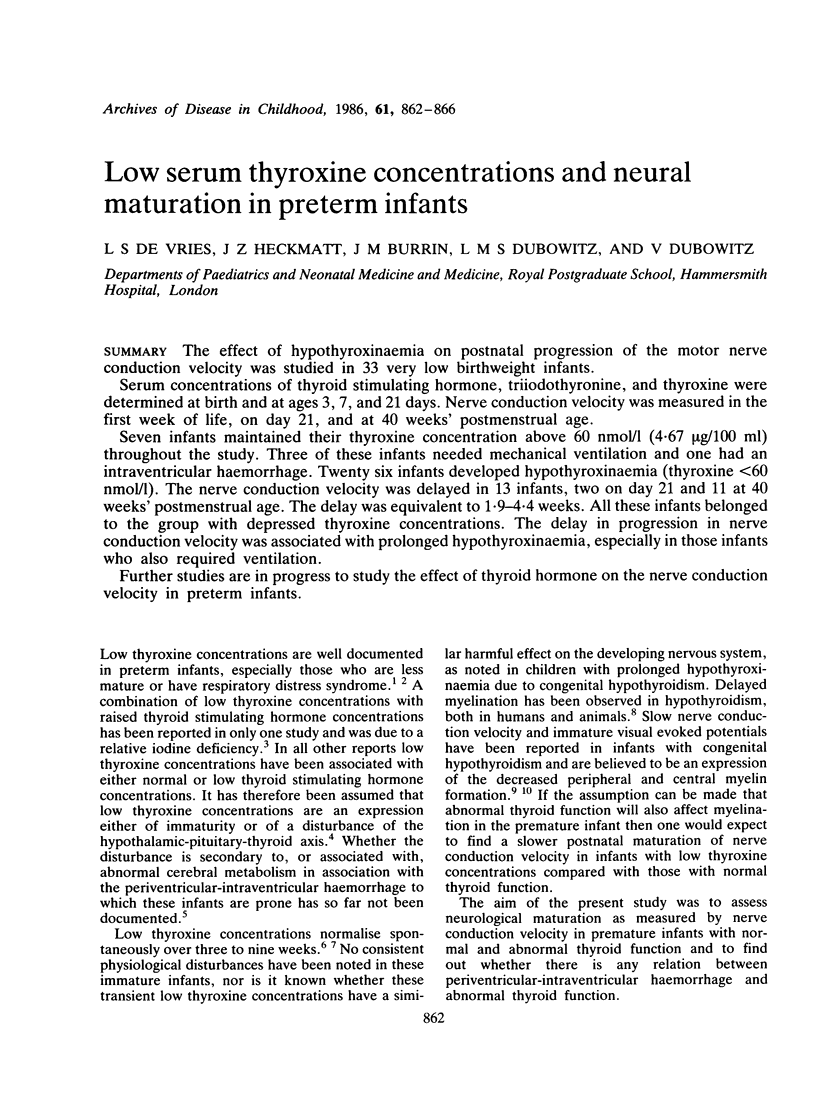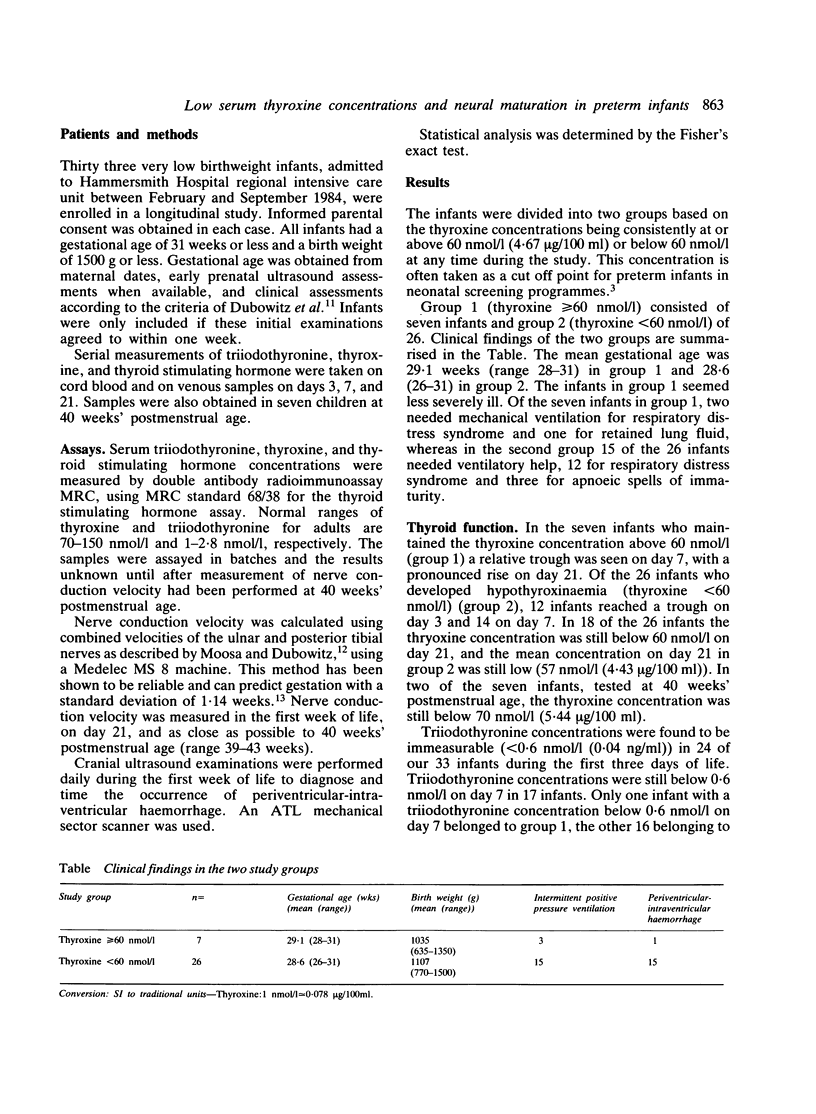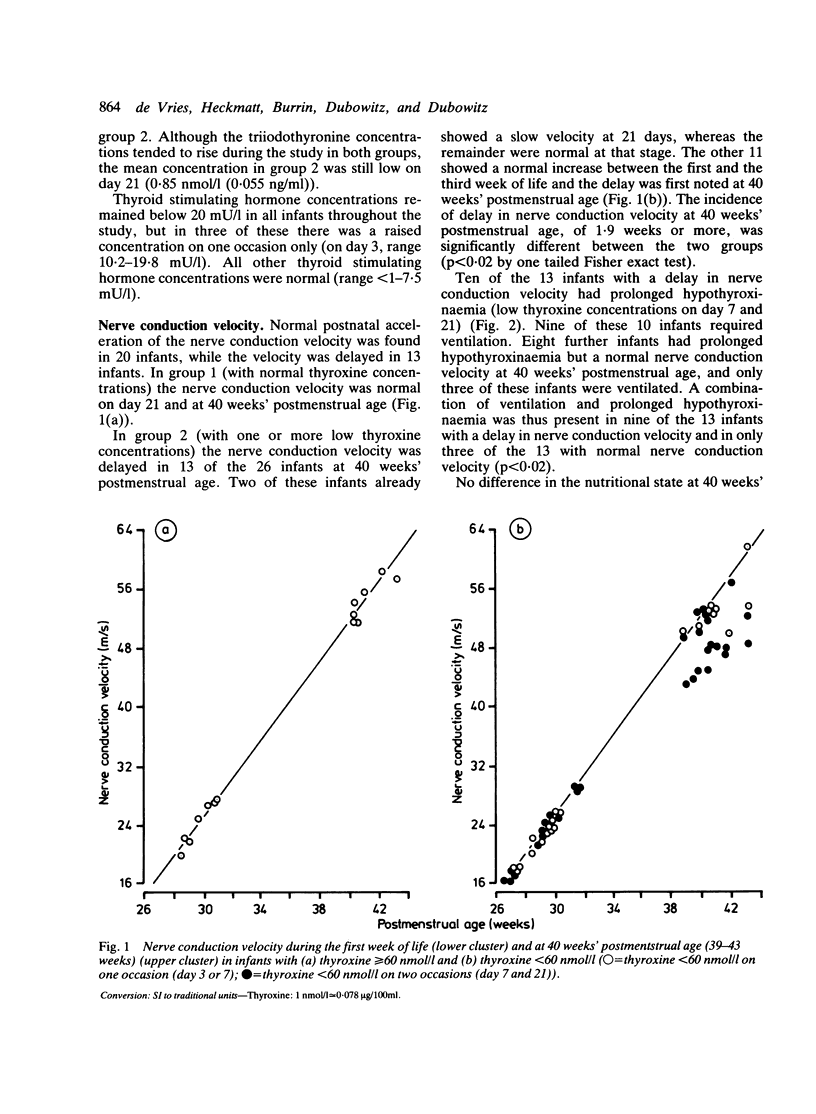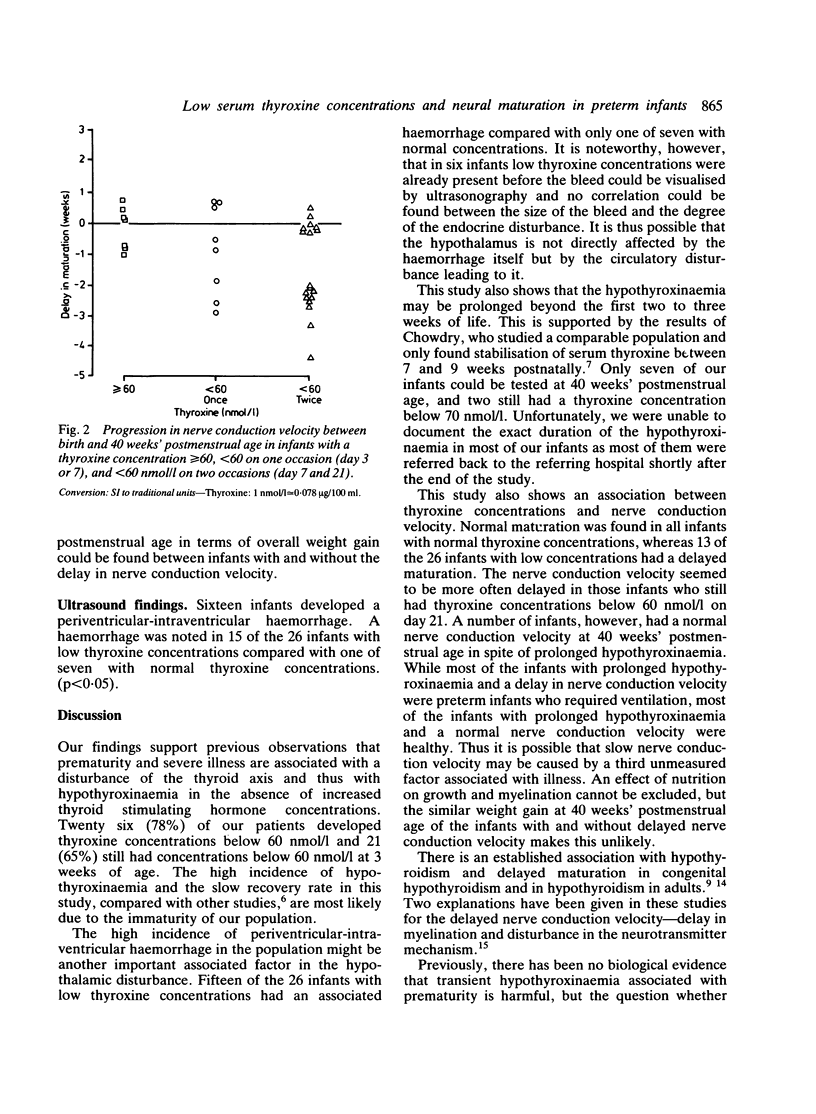Abstract
The effect of hypothyroxinaemia on postnatal progression of the motor nerve conduction velocity was studied in 33 very low birthweight infants. Serum concentrations of thyroid stimulating hormone, triiodothyronine, and thyroxine were determined at birth and at ages 3, 7, and 21 days. Nerve conduction velocity was measured in the first week of life, on day 21, and at 40 weeks' postmenstrual age. Seven infants maintained their thyroxine concentration above 60 nmol/l (4.67 micrograms/100 ml) throughout the study. Three of these infants needed mechanical ventilation and one had an intraventricular haemorrhage. Twenty six infants developed hypothyroxinaemia (thyroxine less than 60 nmol/l). The nerve conduction velocity was delayed in 13 infants, two on day 21 and 11 at 40 weeks' postmenstrual age. The delay was equivalent to 1.9-4.4 weeks. All these infants belonged to the group with depressed thyroxine concentrations. The delay in progression in nerve conduction velocity was associated with prolonged hypothyroxinaemia, especially in those infants who also required ventilation. Further studies are in progress to study the effect of thyroid hormone on the nerve conduction velocity in preterm infants.
Full text
PDF




Selected References
These references are in PubMed. This may not be the complete list of references from this article.
- Abbott R. J., O'Malley B. P., Barnett D. B., Timson L., Rosenthal F. D. Central and peripheral nerve conduction in thyroid dysfunction: the influence of L-thyroxine therapy compared with warming upon the conduction abnormalities of primary hypothyroidism. Clin Sci (Lond) 1983 Jun;64(6):617–622. doi: 10.1042/cs0640617. [DOI] [PubMed] [Google Scholar]
- Bass N. H., Young E. Effects of hypothyroidism on the differentiation of neurons and glia in developing rat cerebrum. J Neurol Sci. 1973 Feb;18(2):155–173. doi: 10.1016/0022-510x(73)90003-8. [DOI] [PubMed] [Google Scholar]
- Chowdhry P., Scanlon J. W., Auerbach R., Abbassi V. Results of controlled double-blind study of thyroid replacement in very low-birth-weight premature infants with hypothyroxinemia. Pediatrics. 1984 Mar;73(3):301–305. [PubMed] [Google Scholar]
- Delange F., Dalhem A., Bourdoux P., Lagasse R., Glinoer D., Fisher D. A., Walfish P. G., Ermans A. M. Increased risk of primary hypothyroidism in preterm infants. J Pediatr. 1984 Sep;105(3):462–469. doi: 10.1016/s0022-3476(84)80030-x. [DOI] [PubMed] [Google Scholar]
- Dubowitz L. M., Dubowitz V., Goldberg C. Clinical assessment of gestational age in the newborn infant. J Pediatr. 1970 Jul;77(1):1–10. doi: 10.1016/s0022-3476(70)80038-5. [DOI] [PubMed] [Google Scholar]
- Hadeed A. J., Asay L. D., Klein A. H., Fisher D. A. Significance of transient postnatal hypothyroxinemia in premature infants with and without respiratory distress syndrome. Pediatrics. 1981 Oct;68(4):494–498. [PubMed] [Google Scholar]
- Hrbek A., Fällström S. P., Karlberg P., Olsson T. Clinical application of evoked EEG responses in infants. III: congenital hypothyroidism. Dev Med Child Neurol. 1982 Apr;24(2):164–172. doi: 10.1111/j.1469-8749.1982.tb08795.x. [DOI] [PubMed] [Google Scholar]
- Klein A. H., Foley B., Foley T. P., MacDonald H. M., Fisher D. A. Thyroid function studies in cord blood from premature infants with and without RDS. J Pediatr. 1981 May;98(5):818–820. doi: 10.1016/s0022-3476(81)80856-6. [DOI] [PubMed] [Google Scholar]
- Levene M. I., Fawer C. L., Lamont R. F. Risk factors in the development of intraventricular haemorrhage in the preterm neonate. Arch Dis Child. 1982 Jun;57(6):410–417. doi: 10.1136/adc.57.6.410. [DOI] [PMC free article] [PubMed] [Google Scholar]
- Miller G., Heckmatt J. Z., Dubowitz L. M., Dubowitz V. Use of nerve conduction velocity to determine gestational age in infants at risk and in very-low-birth-weight infants. J Pediatr. 1983 Jul;103(1):109–112. doi: 10.1016/s0022-3476(83)80792-6. [DOI] [PubMed] [Google Scholar]
- Moosa A., Dubowitz V. Assessment of gestational age in newborn infants: nerve conduction velocity versus maturity score. Dev Med Child Neurol. 1972 Jun;14(3):290–295. doi: 10.1111/j.1469-8749.1972.tb02592.x. [DOI] [PubMed] [Google Scholar]
- Moosa A., Dubowitz V. Slow nerve conduction velocity in cretins. Arch Dis Child. 1971 Dec;46(250):852–854. doi: 10.1136/adc.46.250.852. [DOI] [PMC free article] [PubMed] [Google Scholar]
- Soulioti A. M., Al Roomi L. Transient neonatal hypothyroidism in very low birthweight infants: is treatment necessary? Lancet. 1985 Aug 31;2(8453):493–494. doi: 10.1016/s0140-6736(85)90416-7. [DOI] [PubMed] [Google Scholar]
- Uhrmann S., Marks K. H., Maisels M. J., Friedman Z., Murray F., Kulin H. E., Kaplan M., Utiger R. Thyroid function in the preterm infant: a longitudinal assessment. J Pediatr. 1978 Jun;92(6):968–973. doi: 10.1016/s0022-3476(78)80379-5. [DOI] [PubMed] [Google Scholar]
- Uhrmann S., Marks K. H., Maisels M. J., Kulin H. E., Kaplan M., Utiger R. Frequency of transient hypothyroxinaemia in low birthweight infants. Potential pitfall for neonatal screening programmes. Arch Dis Child. 1981 Mar;56(3):214–217. doi: 10.1136/adc.56.3.214. [DOI] [PMC free article] [PubMed] [Google Scholar]


